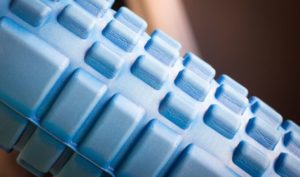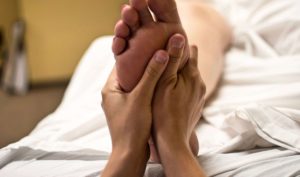What is Plantar Fasciitis?
Your plantar fascia is a connective tissue on the bottom of your feet, basically helping to connect your toes to your heel, and giving your foot its arch. Plantar Fasciitis is when that connective tissue becomes inflamed and starts causing discomfort. Make sure you’ve seen a GP so that you know you’re working with plantar fasciitis, as there can be a few other injuries in this area with similar symptoms. If your GP or physio has told you that you’ve got plantar fasciitis, here are some things that can help speed up the recovery:
Frozen water bottle

Good if the arches of your feet are very inflamed and sore. While inflammation is a natural and necessary part of healing, swelling around the injury site can cause damage to nearby healthy tissue. Try freezing a bottle of water and rolling the arch of your foot on it to provide a bit of self massage, while helping to reduce the inflammation
Tennis or golf ball massage
While sitting on the bed first thing in the morning, or on a chair/ couch at the end of the day, you can try rolling a ball around underneath your foot, adjusting the pressure as needed. Golf balls have the advantage of being cold and hard (if you like firm pressure), and tennis balls are much softer, so it really comes down to personal preference and what is lying around.
Compression socks or sleeves during exercise
Compression sleeves and socks improve circulation and reduce swelling in legs and feet. Wearing compression sleeves or socks can be helpful to reduce lactic acid buildup in the legs and feet when worn during exercise, minimising sore muscles afterwards.
I would recommend visiting a running store such as Pure Performance on Darby Street or in Warners Bay for these as they measure your calves / feet for the perfect size.
Foam roll calves
 If the plantar fasciitis is being caused by tight calves, then rolling out the calves before and after exercise can help to stay on top of the muscle tightness, and introduce fresh blood flow to the area. Watch Dan from Corefit Newcastle show how to foam roll your calves by clicking here.
If the plantar fasciitis is being caused by tight calves, then rolling out the calves before and after exercise can help to stay on top of the muscle tightness, and introduce fresh blood flow to the area. Watch Dan from Corefit Newcastle show how to foam roll your calves by clicking here.
Changing arch support or shoes
If you’ve just recently started wearing a new pair of shoes before noticing the symptoms of plantar fasciitis (regardless of how expensive the shoes were), it’s worth checking if this is the cause. Sometimes arch support can also be too high or too low.
Strapping
Strapping can help by dispersing the pressure in the foot. Strapping is useful for exercise or standing all day at work. Click here for a a helpful video of strapping for feet:
Sleep with a foot splint
The reason why your plantar fasciitis can feel more painful in the morning when you first wake up and start walking is because while you’re asleep, your foot is relaxed and the plantar fascia is contracted. Then when you wake up, and don’t warm your foot up before standing on it, your foot is suddenly stretched and load bearing your body weight, causing micro tears on the plantar fasciitis to reopen after healing overnight. A foot splint helps prevent this by keeping your foot flexed overnight while you’re sleeping. It essentially looks like a moon boot with a strap that can control how much you can bend your foot. These can be found online when searching for a Plantar Fasciitis Splint.
Stretching
Here are some stretches that are recommended daily, before getting out of bed.
- With your leg outstretched in front of you, use a towel to pull back on the top of the foot. You should feel a stretch in the bottom of your foot and your calf, hold this for 30 seconds.
- With your leg outstretched in front of you, bend your toes forward as if trying to make your toes touch the bottom of your heel. Then try to flex your toes as much as possible by trying to make them reach the front of your ankle without moving the rest of your foot.
- With your leg out in front of you, bend your foot and ankle back and forth.
- With your leg bent so that your foot is in your lap, pull back the top of the foot so that your toes are bending backwards, and massage the sole / arch of the foot.
If you’re feeling a bit confused on what these stretches should look like, click here to check them out.
Massage
 Remedial massage is a natural pain relief for plantar fasciitis. The fascia in the calves is continuous with the plantar fascia in the feet, so massage in calves as well as the feet can be quite helpful! Massage can help to relax the muscles in the leg for you to start stretching and strengthening.
Remedial massage is a natural pain relief for plantar fasciitis. The fascia in the calves is continuous with the plantar fascia in the feet, so massage in calves as well as the feet can be quite helpful! Massage can help to relax the muscles in the leg for you to start stretching and strengthening.
Podiatrist
It’s important to find a podiatrist that will look above the feet and also treat the calves. Podiatrists can help to supply insoles or shoes that will provide better support for the plantar fascia.
Physio
If you’re not already working with one to resolve this problem, it’s highly recommended. A physio will give exercises that strengthen your calves or feet, incase that’s the cause to the foot pain. A physio will also be able to look at what else may be causing it. Some physios can do strapping and dry-needling to treat the plantar fasciitis.
With any of the above methods, if they work, that’s great, if they don’t help or aggravate your foot- stop doing that particular thing.

Author: Shelle Dixon
Shelle Dixon is a remedial massage therapist and founder of Seashelle Massage. Shelle is passionate about helping get you back out to the things you love, and keeping you there. You can learn more on here website at seashellemassage.com.au
Share


